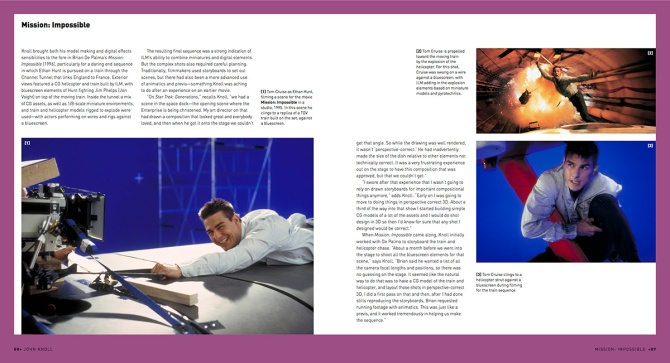
The Mission: Impossible spread from Masters of FX, detailing ILM and John Knoll’s work on the film, today celebrating its 20th anniversary.
1996 really was a big year in film releases and in vfx break-throughs. Mission: Impossible might not necessarily be thought of as a vfx blockbuster in the same vein as Twister or Independence Day from that year, but in many ways it ushered in several new techniques and drew upon a raft old ones to help tell this thrilling first story in the M:I franchise. Now 20 years old, here’s a quick look back at one particular technique – projecting mapping – that was used on the film at a time that the effect was still not all that common.
Leading ILM on Mission: Impossible was visual effects supervisor John Knoll. In my chapter on Knoll in Masters of FX, he recounted the stunning old-school miniatures work for the dramatic helicopter/train sequence while also elaborating on how he approached the planning and storyboarding for the climax of the film. Plus, shots leading up to that sequence included a series of matte paintings achieved via projection mapping, something Knoll would continue to develop further, especially for the pod race in The Phantom Menace.
Here’s an excerpt from my original interview with Knoll for the book, in which he talks about how he came to rely on projection mapping approaches in a much bigger way than on previous shows (it had also been employed on Terminator 2 and Hook):
I was talking to a friend at Electric Image and I explained this idea of camera mapping and it took a little while to explain what I wanted to do. And he suddenly went, ‘Oh the UV co-ordinates come from a projection to camera frustum – oh I can write that in like an hour!’ And he wrote me a little plugin for Electric Image that did that where you could pass it to a camera and the geometry you wanted to texture from it, and we’d do these camera mappings and it was really easy to use.
A bunch of people in our matte department had started using Electric Image and Paul Huston was one of my co-conspirators – we did these projection maps on Mission: Impossible and then a whole bunch more on Star Trek: First Contact and then the Star Wars Special Editions.
By this time the technique looked really promising, and we felt that it gave a very new take on matte painting – it wasn’t the static kind of look that had been done before. When I needed to do all these computer generated landscapes for the pod race (in Phantom Menace) I was worried that I hadn’t seen anybody do a completely synthetic environment that really looked believable. There were programs out there that did fully synthetic terrains but they looked super fake – you would never believe you were looking at a photograph. But this projection mapping technique – you could take a photograph and do this image warping trick with it.
Download the Mission: Impossible page from Masters of FX.
For more on the VFX of Mission: Impossible, check out:
Cinefex 67: http://www.cinefex.com/backissues/issue67.htm

Post a Comment